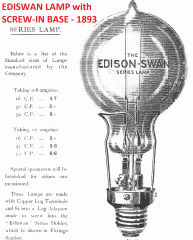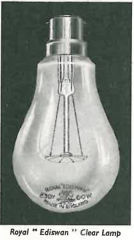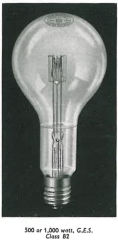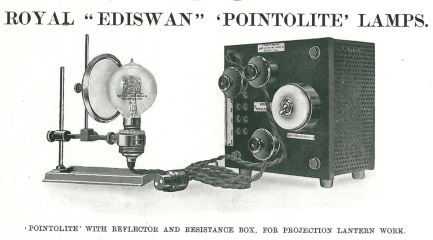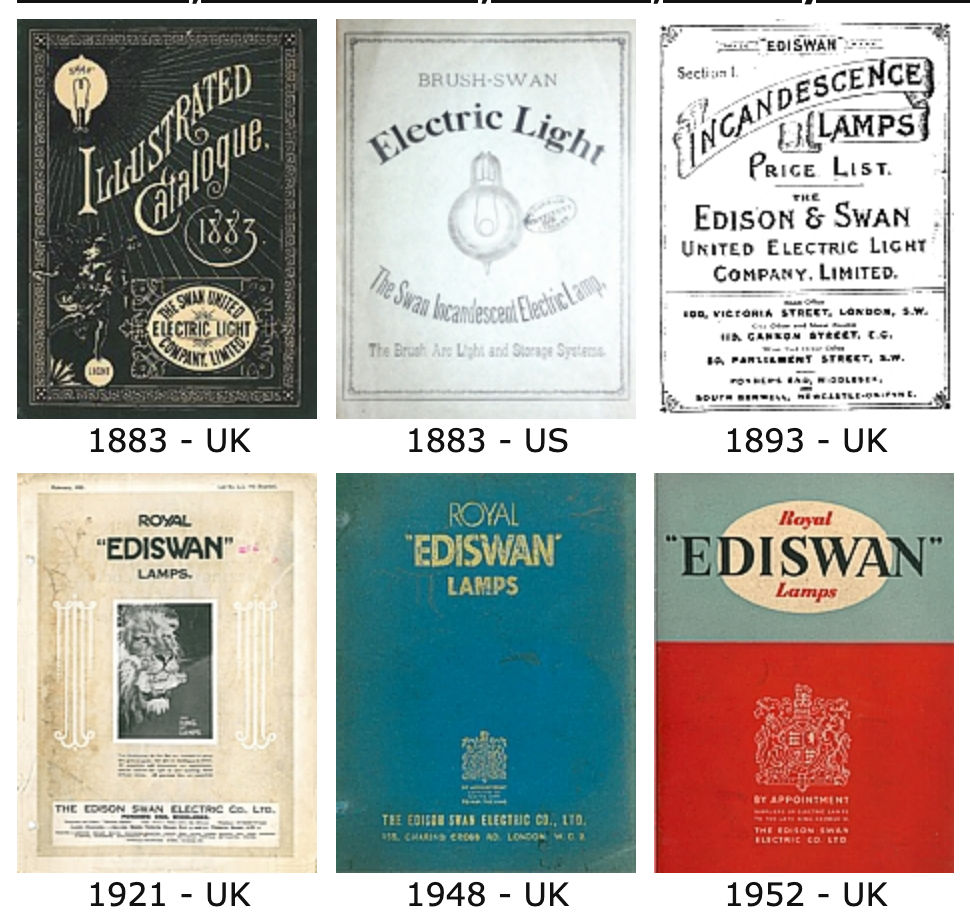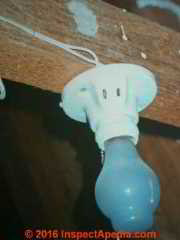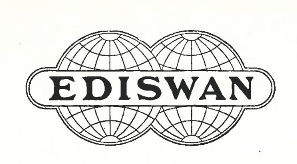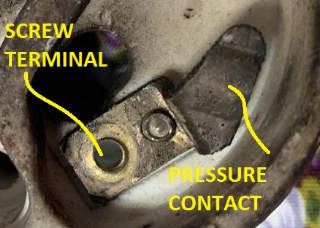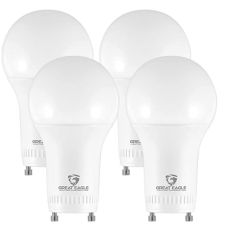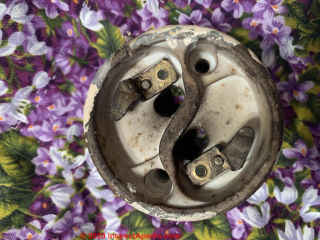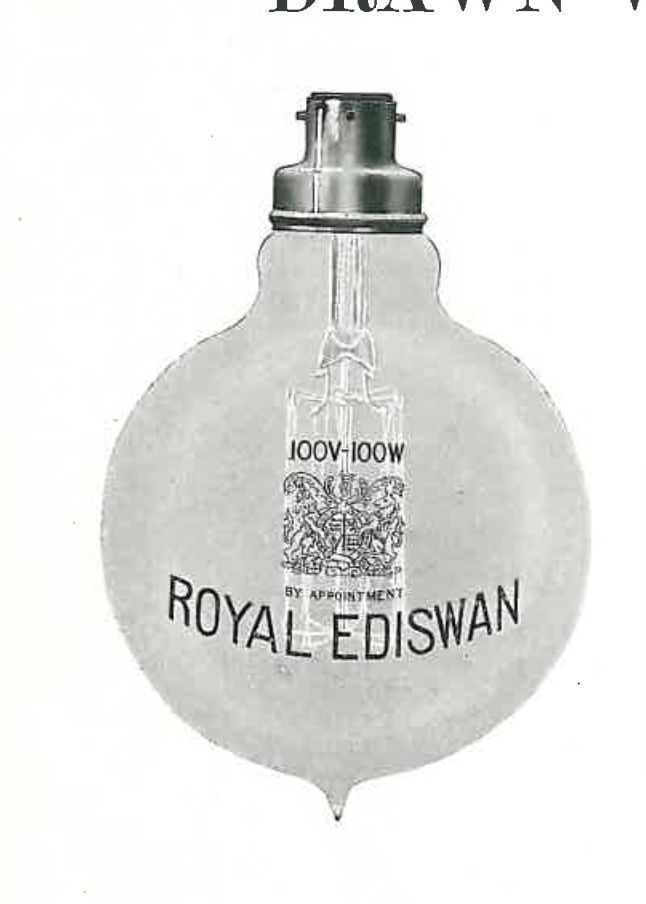 Antique & Old Light Bulbs
Antique & Old Light Bulbs
Photo Guide, Light Output, & Catalogs of Antique Lamps (Bulbs)
- POST a QUESTION or COMMENT about old house wiring, knob & tube, old fuse panels, old house wiring condition & safety
History of.
These photos help identify types, condition, & uses of antique lighting bulbs or lamps, and bulb or lamp sockets, wiring, voltages, current use (Amps) and power consumption (watts) vs. output in amount of light measured in lumens or candelas or candlepower.
Photo above: Ediswan high power lamp from 1921.
In this article series we list common old building electrical wiring system safety concerns and we illustrate types of old electrical wires and devices. This article series answers basic questions about assessing and repairing the electrical service, capacity, wiring type, condition, and safety in older homes.
InspectAPedia tolerates no conflicts of interest. We have no relationship with advertisers, products, or services discussed at this website.
- Daniel Friedman, Publisher/Editor/Author - See WHO ARE WE?
Antique Lamp ("Light Bulb") Identification, Catalogs, History, References
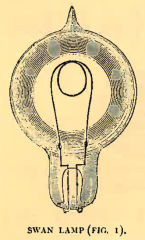
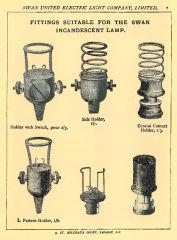 Above: from 1883, early Swan lamp base details showing the bulb connections (wires) and bulb or lamp base options. Thanks to James D. Hooker's Museum of Electric Lamp Technology (cited below), to the Franklin Institute (Philadelphia PA) along with some additional resources on antique electrical devices, lamps, bulbs, wiring, generators.
Above: from 1883, early Swan lamp base details showing the bulb connections (wires) and bulb or lamp base options. Thanks to James D. Hooker's Museum of Electric Lamp Technology (cited below), to the Franklin Institute (Philadelphia PA) along with some additional resources on antique electrical devices, lamps, bulbs, wiring, generators.
- 2yr.net LIGHT BULB COLLECTION [website] photo gallery of vintage light bulbs by type of connector & use
- BULB & LAMP TYPES GUIDE - [InspectApedia.com page] home
- BRUSH SWAN INCANDESCENT LAMP CATALOG 1883 [PDF] -The Brush Arc Light and Storage Systems,
New York NY, retrieved 2020/11/14 original source: Franklin Institute, retrieved from http://www.lamptech.co.uk/Documents/Catalogues/Brush-Swan%20-%20Catalogue%20-%201883%20US.pdf
Brush Electric Company was located at 379 Euclid Ave. Cleveland OH USA.
Excerpts:
The difficulty of dividing the electric current for the economical production of incandescent light has been practically solved by the invention of the Swan Incandescent Lamp. By its means separate lights of various powers and applicable ot all the uses of ordinary gas burners, or other artificial light, may be produced.
The Swan Lamp may be fed direct from the dynamo-electric machine, or from secondary batteries or from other available sources of electricity.
The Swan lamp is extremely simple in its construction and may be describe as follows: a small glass globe from which all air has been exhausted, and in which is fixed a thin filament of carbon.
On passing the electric current through the carbon it beomes intensely white hot and emits a beautifully soft, clear, and steady light. As the carbon is not in contact with the air there is no combustion, and therefore, no deterioration of the atmosphere of the room in which it is used, and the heat given off is imperceptible.
The lamp has no mechanism and when it fails from use or accidental breakage is as easily replaced by a new one as a candle is placed in a candle-stick.
The power of the Swan Lamp ranges from 3 candles to 100 candles, the stnadard size, however, being 16 candles, or somehwat more than an ordinary gas burner.
...
The light is turned off or on by means of a key, or button, made of rubber, and each lamp is entirely independent of the others or they may be arranged in groups if desired.
Below: ten years later, from the Ediswan price list, we see both early Swan lamps and also the newer "Ediswan" lamp terminal showing what is often referred to as an Edison-base lamp holder - a threaded socket allowing the user to screw in the bulb for what was considered a more-secure and more-reliable electrical contact and lamp support.
By 1893 the highest candlepower of lamps or "bulbs" had increased from about 100 candlepower to 1000 candlepower, denominated "Sunlight Lamps".
Candlepower is still used in some literature and is measured in candelas. Other measurements of light, including footcandles (one lumen per square foot = 1 footcandle), Lumens, and Watts are more widely used today.
- EDISON & SWAN UNITED ELECTRIC LIGHT CO. Ltd. - UK 1893 [PDF] Ediswan lamp price list, with multiple offices in the U.K., headquartered at 100 Victoria St., London SW, England, U.K.
- EDISON & SWAN ELECTRIC CO., Ltd., EDISWAN LAMP CATALOG - UK 1921 [PDF] provides a catalog of lamps from February 1921, retrieved 2020/11/14 original source: http://www.lamptech.co.uk/Documents/Catalogues/Ediswan%20-%20Catalogue%20-%201921%20UK.pdf
By 1921 Edison & Swan were producing drawn wire filament lamps, gas-filled lamps, carbon filament lamps, in a range of designs for high candlepower applications, downlights, and special purposes such as radiator lamps, electric candles, and Turbolite, Linolite, and Pointolite lamps and accessories.
Lamps were sold for operation at various voltages, typcially 25 V to 250 V and at wattages from 10W to 100W. These lamps could be used on either AC (Alternating Current) or DC (Direct or "Continuous" Current). - Thomas A. Edison, ELECTRIC LIGHTING SYSTEM [PDF] Patent NO. 439,392, granted 28 October 1890
Excerpt: The object I have in view is to produce means to be used in connection with dynamo or magneto-electric machines supplying electric lamps or other translating devices arranged in multiple arc, which means will prevent injury to the machine or machines when an abnormally large current is caused to flow by the addition of more lamps or other translating device than the plant has capacity to furnish, and will at the same time notify the engineer of the condition of affairs.
The Ediswan lamps or "bulbs" below are from the 1948 catalog.
Above: first photo, a general purpose, 60W clear Ediswan lamp intended for lighting and featured in the company's 1948 catalog. Notice above the design of the bulb base, using two locking pins rather than threading into a bulb socket.
Our second photo above shows a general purpose Schedule "A" type projector lamp. These lamps were sold to operate at various voltages: 12, 20, 40, 100, 110, 115 and in wattages from 15W to 1000W. The bulb life was typically 25-50 hours!
Below: the Edison PointoLite lamp and projector transformer.
- The Franklin Institute, 222 North 20th Street, Philadelphia, PA 19103 - located in Center City Philadelphia, at the intersection of 20th Street and the Benjamin Franklin Parkway, Website: https://www.fi.edu/
- James D. Hooker's Museum of Electric Lamp Technology, Website: http://www.lamptech.co.uk
Mr. Hooker discusses and illustrates types of incandescent lamps, halogens, semiconductors, fluorescents, sodium vapour, mercury vapour, metal halide, gas discharge and other types of lamps - or as many of our readers say in more lay vernacular, "light bulbs".
His museum includes a wonderful collection of lamp catalogs from both U.S. and U.K. sources.
Website excerpt:
The first artificial electric light was demonstrated during 1802 in London, by Sir Humphry Davy at the Royal Institution of Great Britain.
It was the carbon arc discharge lamp, and since then the electric discharge has been intensely researched and developed for one fundamental reason - that it creates light from electricity more efficiently than any other kind of artificial light source. - ROYAL EDISWAN LAMPS CATALOG 1948-UK [PDF] Ediswan lamp catalog for the UK, The Edison Swan Electric Co., Ltd. 155 Charing Cross Road, London W.C.2, Tel: Gerrard 8660, retrieved 2020/11/14 original source: http://www.lamptech.co.uk/Documents/Catalogues/Ediswan%20-%20Catalogue%20-%201948%20UK.pdf
By 1948 the Edison Swan Electric Co. had retail outlets in over twenty UK locations with additional storage locations as well.
Catalog Excerpt:
The modern electric lamp emanated from the work of two great men.Sir Joseph Wilson Swan introduced the first prcactical Carbon Lamp in 1878, and the same year Thomas Alva Edison was experimenting with a similar lamp which was the subject of a British patent in 1879.
In 1883 the interests of Edison and Swan were amalgameted by the formation of the Edison and Swan United Elecctric Light Company, Ltd., which in 1916 became the Edison Swan Electric Co., Ltd., the manufacturers of the Royal "Ediswan" Lamps. - SWAN UNITED ELECTRIC LIGHT CO. CATALOG - UK 1883 [PDF] courtesy of Hooker's Museum cited above, this is the earliest lamp catalog we've found, and a good reference for identifying types of oldest lamps and lamp bases or connectors.
In the U.K. and Europe The Swan United Electric Light Company Ltc., had offices at Swan United Electric Light Co. Ltd., 9 Mildred's Court E.C., London; 13 Mosley St., Newcastle on Tyne, and sur le Rue Charlot, 83, Paris, France.
As illustrated above, lamps from Swan used two platinum wires extending out of an evacuated glass bulb base, connecting to two wire contacts in the bulb base.
Above: a modern lamp and ceramic lamp socket improperly wired using lamp cord or "zip cord".
Antique vs. Modern Lamp or Bulb Identification, Output, Watts, Lumens
Below we compare the light output and power consumption of these earliest lamps or bulbs with modern light bulbs of several types.
Bulb Types vs Watts1 vs Light Output in Lumens |
||
| Bulb Type | Watts | Lumens |
| Incandescent Swan Lamp 1883 | 1452 | 624 |
| Incandescent Ediswan Lamp 1893 | 2203 | 1400 |
| Modern Incandescent | 100 | 1600 |
| Modern Halogen | 72 | 1600 |
| Modern CFL10 | 26 | 1600 |
| Modern LED 10 | 22 | 1600 |
Notes to the table above
- When comparing watts in older electrical systems remember to note the actual voltage level as well as current level in amps, as those were nowhere consistant across various lighting systems and electrical generators.
- The 1883 Swan United Electrical Co Catalog (PDFprovided below) shows typical lamp capacities ranging from 2 - 100 candlepower at 6-100 volts and using typically from 0.6 to as much as 27 amps.
A 50 candlepower lamp was listed as powered at 50 V and using 2.9A or about 145W
A 100 candlepower lamp was listed as powered by 100 V using 3A or about 300W
We convert candlepower(CP) to lumens (L) as
L = CP x 0.918 x 12.6
The derivation of this formula is in items 4-5 below. - The 1893 Ediswan lamp price list (PDF provided below) lists "standard voltages" ranging from 2 volts to 110 Volts, with an 80-110V power supply lamp providing up to 1000 nominal candle-power.
A 1-candlepower bulb, operating at 2-12 Volts, sold for 3 shillings 9pence and at 10A the 1893 Edison-Swan lamp shown above produced between 16 and 50 candlepower.
The electrical data of voltage, current in Amps, and candlepower are incomplete and so a bit confusing but from p. 4 in the 1893 UK catalog we have on p. 18
we have a "high efficiency" 100 CP lamp drawing 2.0 A at 110V where (Volts x Amps) = Watts = 110 x 2 = 220 W
- Candlepower is an older measure of light emission from a source
1 candlepower = 0.918 Candelas - Candelas: Candelas measure the amount of light emitted in a specific direction.
1 candela = luminous intensity of a light source (@ 540 Thz) with a power of 1/683 watts per steradiain = 18.4 milliwatts over the sphere centered at the light source, or roughly,
1 candela = 0.0184 Watts
Watch out: it's tricky to try to convert measures of light such as candelas (since 1943) or lumens to watts, because the total electrical power or watts required to produce a given amount of light (measured for example in lumens) varies considerably depending on the type of bulb.
1 candela = 12.6 lumens
- Lumens: L or lm = Lumens measure the total amount of light emitted by a light source
1 lumen = 0.8 candelas, or
1 lm = 1 cd x sr.
A full sphere has a solid angle of 4π steradians, so a light source that uniformly radiates one candela in all directions has a total luminous flux of
1 cd × 4π sr = 4π cd x sr ≈ 12.57 lumens. - Wikipedia 2020/11/14
where
cd = candelas, sr = steradians and lm = lumens
- Lux: measures the amount of light that is cast on a surface, or illuminance, measured in lux.
- (Volts x Amps) = Watts
- See details at BULB & LAMP TYPES GUIDE - home
- CFL = Compact Fluorescent lamp or "bulb" and LED = light emitting diode type lamp or "bulb"
- See also
Above: the Ediswan Logo from the company's 1921 lamp catalog cited and discussed below.
...
Reader Comments, Questions & Answers About The Article Above
Below you will find questions and answers previously posted on this page at its page bottom reader comment box.
Reader Q&A - also see RECOMMENDED ARTICLES & FAQs
On 2020-11-14 - by (mod) - identify this lamp base or "ceiling light box" ?
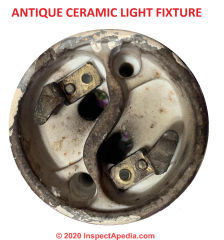 Anon
Anon
Thank you for the question and interesting photo of an apparently antique porcelain electrical fixture connector.
[Click to enlarge any image]
I do not recognize this exact fitting nor can I give a year of its use, nor can I confirm that it is a "ceiling box for lights"
Though lamps (or "light bulbs") were in use much earlier, in North America light bulbs in wide use date from about 1901.
It is easy to stump-the-chump (me) when we have not a shred of information about an old electrical device.
What I can see is porcelain, soiling on the porcelain and oxidation on two brass clip-type connectors.
All I can see are what appear to be lamp or bulb base contacts without the components that would hold a bulb in place.
From the connector design these connectors may have been designed for a twist-and-connect device (or bulb with uncommon connector studs).
You suggested this is probably a ceramic ceiling rosette intended to hold a light bulb.
Ultimately I agree with you but claim that we might be missing some critical parts - in particular, a surround that would better support a bulb base.
A two-pin type light bulb might indeed have been installed by twisting the bulb so that the edge of the bulb pins slipped under the clips in your photo. On the upper surface of the clips in the photo I see no marks suggesting regular contact.
Among the older pin type lamp contacts such as shown in this article I have not (yet) found a twist-to-secure bulb base but of course such may have existed.
As you will see in the Leviton example below, a typical porcelain light device uses an Edison bulb connector: a shell (neutral wire) and a center stud in the base bottom (hot wire) that connect to a screw-in type lamp or "light bulb".
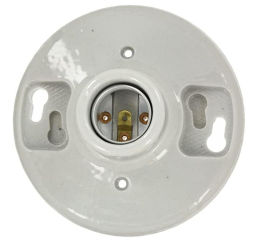
Your device is quite different.
Identify Antique Light Bulbs Types Bases "Lamps"
It would be helpful to know about the building where this fitting was found:
Location: County, city,
Building age
and to see
Photos of other building wiring details or remnants such as knob and tube wiring
Photo of this fitting as found, in-use, with devices or wires connected.
An interesting website (2yr.net) on antique light bulbs, at 2yr.net Light Bulb Collection ( https://bulbs.2yr.net/galleries.php ) cited above on this page, shows a number of antique light bulbs and their connections, even some bulbs used before 1900.
Looking at those I do not see a bulb that would seem to connect to your porcelain device.
I asked that website editor to take a look at your photo (their message board doesn't appear to accept photos) and he was kind enough to comment as follows:
I've never seen an item like this before. But if I had to guess, I would guess it might be the bottom part of a two piece bulb socket, with a proprietary twist lock design... it's possible. Sometimes porcelain sockets came in a two-piece design that allowed for all the wiring and mounting screws to be hidden under a porcelain cover. I'm not entirely convinced that's what I'm looking at, but it is my best guess.
I can't think of any light bulb base that would attach into this thing. Or could it be some kind of fuse holder?
It does not look antique to me, but it does look vintage.
Maybe from the 50's and later? It would be helpful to know if it has the UL
mark or any other marks or names anywhere.
During my search I ran into this website, maybe this person could help solve
the mystery? https://www.plugsocketmuseum.nl/
- Editor
, 2yr.net LIGHT BULB COLLECTION by private email 2020/11/14
The closest I [DF] could find among antique lamps (light bulbs) that might have connected to your lamp base are the Brush-Swan or the Schaefer or National lamps whose early pin-type bases are shown below (pending a better photo).
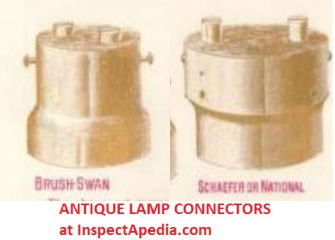
That would date this fixture to the early 1880s - in the U.S. However as I've noted, your porcelain fitting, if it was a lampholder, is incomplete and is missing parts that would hold a bulb in place.
Thanks to James D. Hooker's Museum of Electric Lamp Technology and the Brush Swan Electric Co. Catalogs cited in references given above, along with some additional resources on antique electrical devices, lamps, bulbs, wiring, generators.
Below: modern two-prong bulbs are still marketed, but their bottom connecting studs would not work with the fixtures discussed on this page.
On 2020-11-14 by Anonymous - What year were these used as a ceiling box for lights?
What year were these used as a ceiling box for lights?
This Q&A were posted originally
at OLD ELECTRICAL WIRING TYPES
...
Continue reading at OLD HOUSE ELECTRICAL SYSTEMS or select a topic from the closely-related articles below, or see the complete ARTICLE INDEX.
Or see these
Recommended Articles
- AGE of a BUILDING, HOW to DETERMINE - Visual clues indicate the age of a building
- ANTIQUE LAMPS (BULBS) & CONNECTOR TYPES
- ASBESTOS ELECTRICAL WIRE INSULATION
- ASBESTOS in LAMPS & LIGHT BULBS
- BULB & LAMP TYPES GUIDE - home
- BULB & LAMP ABBREVIATIONS & CODES
- ELECTRICAL COMPONENTS, AGE, TYPES
- FABRIC NMC WIRE INSULATION IDENTIFICATION - age of old electrical wire by trademark data
- ELECTRICAL RECEPTACLE TYPES
- OLD HOUSE ELECTRICAL SYSTEMS - home
- OLD ELECTRICAL WIRING TYPES - timeline of use of different types of electrical wire & wire insulation
- VOLTAGE AVAILABLE in OLDER HOMES
Suggested citation for this web page
ANTIQUE LAMPS (BULBS) & CONNECTOR TYPES at InspectApedia.com - online encyclopedia of building & environmental inspection, testing, diagnosis, repair, & problem prevention advice.
Or see this
INDEX to RELATED ARTICLES: ARTICLE INDEX to ELECTRICAL INSPECTION & TESTING
Or use the SEARCH BOX found below to Ask a Question or Search InspectApedia
Ask a Question or Search InspectApedia
Try the search box just below, or if you prefer, post a question or comment in the Comments box below and we will respond promptly.
Search the InspectApedia website
Note: appearance of your Comment below may be delayed: if your comment contains an image, photograph, web link, or text that looks to the software as if it might be a web link, your posting will appear after it has been approved by a moderator. Apologies for the delay.
Only one image can be added per comment but you can post as many comments, and therefore images, as you like.
You will not receive a notification when a response to your question has been posted.
Please bookmark this page to make it easy for you to check back for our response.
IF above you see "Comment Form is loading comments..." then COMMENT BOX - countable.ca / bawkbox.com IS NOT WORKING.
In any case you are welcome to send an email directly to us at InspectApedia.com at editor@inspectApedia.com
We'll reply to you directly. Please help us help you by noting, in your email, the URL of the InspectApedia page where you wanted to comment.
Citations & References
In addition to any citations in the article above, a full list is available on request.
- Edison, Thomas A. "Manufacture of filaments for incandescent electric lamps." U.S. Patent 470,925, issued March 15, 1892.
- Edison, Thomas A. "Electric conductor." U.S. Patent 470,924, issued March 15, 1892.
- Edison, Thomas A. "Electrical Indicator" U.S. Patent 307,031, issued October 21, 1884.
- Edison, Thomas Alva. "Electric lamp." U.S. Patent 223,898, issued January 27, 1880.
- Hughes, Thomas P. "The electrification of America: the system builders." Technology and Culture 20, no. 1 (1979): 124-161.
- Hughes, Thomas Parke. "British electrical industry lag: 1882-1888." Technology and Culture 3, no. 1 (1962): 27-44.
- Norwig, E. A. "Patents of Thomas A. Edison, The." J. Pat. Off. Soc'y 36 (1954): 275.
- In addition to citations & references found in this article, see the research citations given at the end of the related articles found at our suggested
CONTINUE READING or RECOMMENDED ARTICLES.
- Carson, Dunlop & Associates Ltd., 120 Carlton Street Suite 407, Toronto ON M5A 4K2. Tel: (416) 964-9415 1-800-268-7070 Email: info@carsondunlop.com. Alan Carson is a past president of ASHI, the American Society of Home Inspectors.
Thanks to Alan Carson and Bob Dunlop, for permission for InspectAPedia to use text excerpts from The HOME REFERENCE BOOK - the Encyclopedia of Homes and to use illustrations from The ILLUSTRATED HOME .
Carson Dunlop Associates provides extensive home inspection education and report writing material. In gratitude we provide links to tsome Carson Dunlop Associates products and services.


